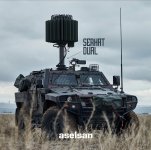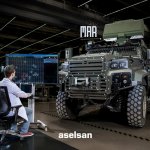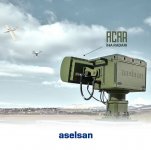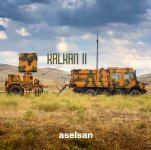Latest Thread
You are using an out of date browser. It may not display this or other websites correctly.
You should upgrade or use an alternative browser.
You should upgrade or use an alternative browser.
ASELSAN technologies are on duty against the developing and diversifying threats of today's battlefield. We continue to play a critical role in the defense of strategic regions with the radar technologies we have developed against all kinds of threats that may come from the air.
- SERHAT-DUAL Multifunctional Weapon Detection Radar
- MAR Mobile Search Radar
- ACAR-UAV Surveillance Radar
- KALKAN-II Medium Altitude Three-Dimensional Mobile Air Defense Radar




- SERHAT-DUAL Multifunctional Weapon Detection Radar
- MAR Mobile Search Radar
- ACAR-UAV Surveillance Radar
- KALKAN-II Medium Altitude Three-Dimensional Mobile Air Defense Radar
Attachments
No need to invest into digital Night vision in the short term. It is simple inferior to analog systems, and Analog night vision is one the biggest deficiency of our armed forces which we need to address asap. Both Motion sickness of screens and millisecond delays are huge disadvantages of Digital night vision tech. A few millisecond is the difference between life and death in battlefield.
I think there should be both options and the choice should be left to the user performing the operation in the field.No need to invest into digital Night vision in the short term. It is simple inferior to analog systems, and Analog night vision is one the biggest deficiency of our armed forces which we need to address asap. Both Motion sickness of screens and millisecond delays are huge disadvantages of Digital night vision tech. A few millisecond is the difference between life and death in battlefield.
The most critical missions require self-protection. ASELSAN IRIS-100 Missile Warning System, which enables the detection of IR-guided missile threats, can detect and track threats from the moment they are launched. IRIS-100, which provides a short reaction time for automatic triggering of countermeasure systems, also has the ability to detect, track and warn for multiple missile threats at the same time.
ASELSAN electro-optical countermeasure systems offer high flight safety to air platforms operating in the field. One of these solutions, ASELSAN LİAS-100 Laser Warning Receiver System, has many superior capabilities such as 360-degree coverage, multiple threat detection and tracking.


ASELSAN electro-optical countermeasure systems offer high flight safety to air platforms operating in the field. One of these solutions, ASELSAN LİAS-100 Laser Warning Receiver System, has many superior capabilities such as 360-degree coverage, multiple threat detection and tracking.
Mr Akyol: (AselFlir500) We are talking about a system that can detect people over 20 kilometers, detect tanks over 80 kilometers, and mark over 20 kilometers. It can do this both day and night. At the same time, it has very high imaging capability in low light environments and especially for the first time in this class, we have also introduced the HD SWIR camera feature"

Akyol: "Unlike our counterparts in the world, we are trying to localize all its components, starting from its chip, detector, INS, GPS, lens. We made these products to avoid any limitations or obstacles"
Great news! We now have a FLIR (Forward looking Infra Red) system to fit in to our helicopters and UAVs that will obviate the need to import these without having to worry about their like for like performance levels.Mr Akyol: (AselFlir500) We are talking about a system that can detect people over 20 kilometers, detect tanks over 80 kilometers, and mark over 20 kilometers. It can do this both day and night. At the same time, it has very high imaging capability in low light environments and especially for the first time in this class, we have also introduced the HD SWIR camera feature"
View attachment 62335
Of course being a FLIR it needs to operate in comparatively clear weather conditions; quite often, under cloud situations. Hence bringing the platform in to range of air defence systems and more importantly possibly in to range of modern man pads.
We should remember that Turkish defence industry has also developed a “Moving Target Indication Synthetic Aperture Radar” through Meteksan Company called MILSAR SAR-MTI. This radar system can identify targets over 150km range and has a weapon targeting range of 27km. it can operate over clouds in any weather condition, drawing a picture of terrain and identifying fast moving and stationary targets , even differentiating between military and civilian personnel through the algorithms it uses.
I think aselflir 500, CATS and wescam images (obvious from the screen interfaces) are being compared (e.g. vibration turbulence).
From left to right, Aselflir 500, CATS and Wescam MX 15.
and my love..
Where is the fourth sensor?
As I understand it, it's not four sensors. The two images on the left (below and above) are AF500, the others are CATS on the upper right (my guess) and the MX 15 image on the lower right.
Edit: It should have been MX-15D not MX-15.
Edit2: Also, as on the upper right is wescam mx-15D display, not CATS.
Last edited:
ASELFLIR-500 was developed as a high-performance electro-optical reconnaissance, surveillance and targeting system for Unmanned Aerial Vehicles (UAVs), helicopters and aircraft. Offering a superior range performance, ASELFLIR-500 will serve its users with many superior capabilities such as precise target location determination, artificial intelligence-supported image processing algorithms and precise stabilization.

What do we have that is going to use FLIR-500 that operates over about 30000 feet? Neither Akıncı nor Aksungur has operational altitude higher than that. Nor any of the helicopters we might use it on, obviously. Also, Aselsan is already working on FLIR-600 for higher altitudes unless I'm misremembering.The lower end of the temperature range has increased from -55 to -40.
Do you have any source on that "civilian component" claim or are you just making it up because of the temperature mentioned?No export customer would believe that your product with only -40°C will be OK while the rival product comes with Mil-std-810G. This will obviously be a con for aselflir export.
ASELSAN might be working on 600, but it is bigger and if there is mil spec component shortage for 500, the same will be valid for 600 too.
Not to mention, what are the price differences between two products? Who are the target users and what platforms they might used them on? How can you say they might choose something else just because of the temperature? And it's not like Aselsan desperately needs Flir-500 to be an export success while we have so many products ourselves that is going to use it.
Edit: I also can't find FLIR-500C ever being mentioned to have -55 operating temperature anywhere, all mentions I can find are about -40. Either you confused storage temperature with operating temperature or I'm going to need a source on your claim of downgrade.
Last edited:
Hendsoldt's ARGOS-II HD or Teledyne Flir's Star SAFIRE® 380-HD has the same operating temperature as ASELFLIR-500.
Last edited:










